7 Diamond Setting Types, Popular Types of Ring Setting

When it comes to buying the perfect engagement or wedding ring, the choice of the diamond setting is just as important as the diamond itself. The setting not only holds the diamond securely but also plays a significant role in the overall aesthetics and style of the ring. There are several popular diamond setting types, each with its own unique characteristics and charm. In this article, we’ll explore these popular diamond setting types in greater detail to help you make an informed choice for your special ring.
Popular Types of Diamond Setting
Prong Settings
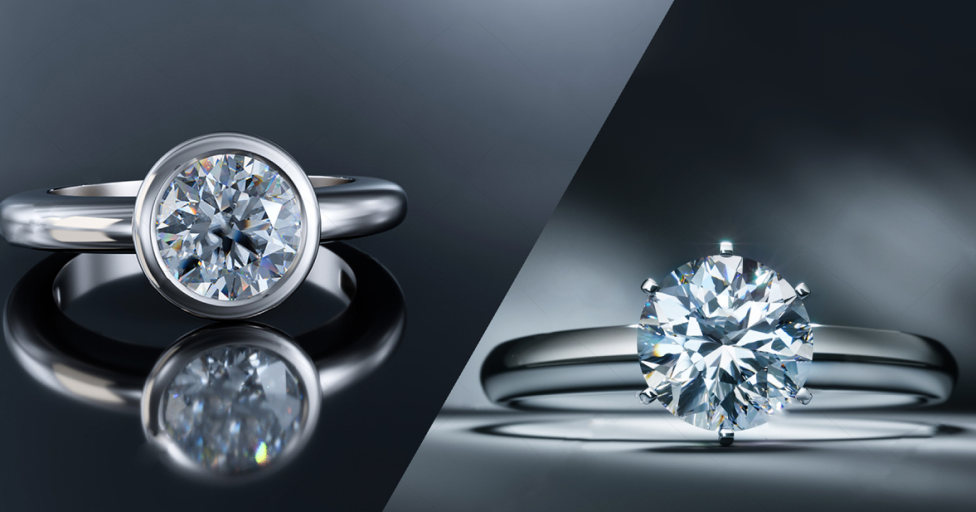
Prong settings, known for their timeless elegance, involve small metal claws (usually four or six) that securely hold the diamond in place. These slender prongs not only provide maximum exposure to the diamond but also allow it to sparkle brilliantly as light can easily enter from various angles. Prong settings are versatile and work well with various diamond shapes, including round, princess, and oval. They offer a classic and sophisticated look that has stood the test of time, making them a popular choice for engagement rings.
| Pros of Prong Setting | Cons of Prong Setting |
| 1. Maximum Diamond Exposure: Prong settings allow for the most exposure of the diamond, enhancing its brilliance and sparkle. | 1. Prongs Can Catch on Objects: The prongs may snag on clothing or objects due to their elevated nature. |
| 2. Timeless and Classic Look: Prong settings offer a timeless and classic appearance that complements various diamond shapes and styles. | 2. Security Concerns: While prongs securely hold the diamond, they may loosen or wear down over time, potentially leading to diamond loss. |
| 3. Versatility: Prong settings are versatile and work well with different diamond shapes, making them a popular choice for engagement rings. | 3. Prongs Require Maintenance: Periodic maintenance to check and tighten prongs may be needed to ensure the diamond remains secure. |
Bezel Settings
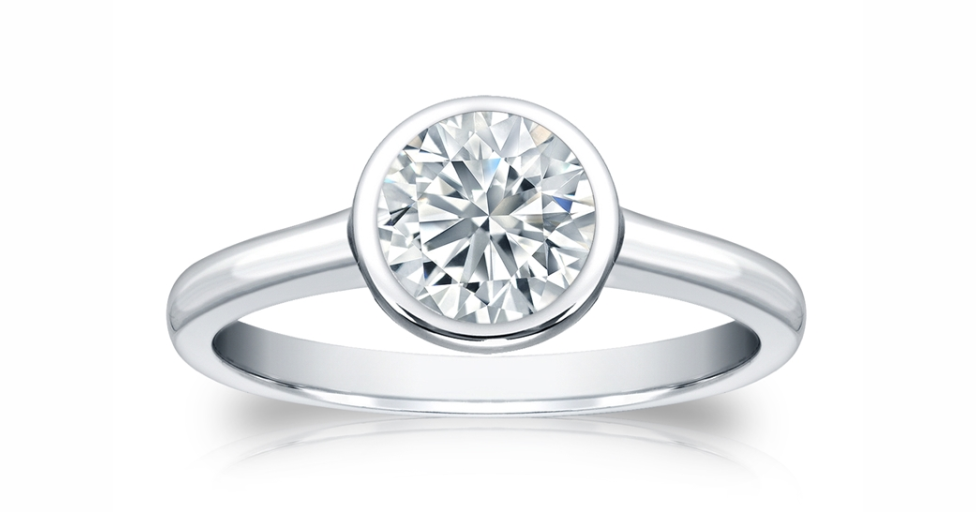
Bezel settings, known for their exceptional security and modern appeal, encircle the diamond with a metal rim, holding it securely in place. It offers excellent protection for the diamond, making it an ideal choice for individuals with an active lifestyle.
Bezel settings have a sleek, contemporary appearance that appeals to those who prefer a minimalist look. They are available in different styles, including full bezel (which fully surrounds the diamond) and partial bezel (which leaves the sides open for added light exposure). Bezel settings offer both durability and a clean, uncluttered aesthetic.
| Pros of Bezel Setting | Cons of Bezel Setting |
| 1. Security: Bezel settings provide excellent security for the diamond, minimizing the risk of it getting loose or falling out. | 1. Less Light Exposure: The metal rim partially covers the diamond, reducing the amount of light that can enter and potentially affecting the diamond’s brilliance. |
| 2. Protection: The metal rim surrounds the diamond, protecting it from chips, scratches, and everyday wear and tear. | 2. Less Sparkle: Compared to prong settings, bezel settings may offer slightly less sparkle because the metal rim obstructs some light reflection. |
| 3. Modern Aesthetic: Bezel settings have a sleek and contemporary appearance that appeals to those who prefer a minimalist and modern design. | 3. Resizing Difficulty: Resizing a ring with a full bezel setting can be more challenging and costly due to the need to adjust the metal rim. |
Pave Settings
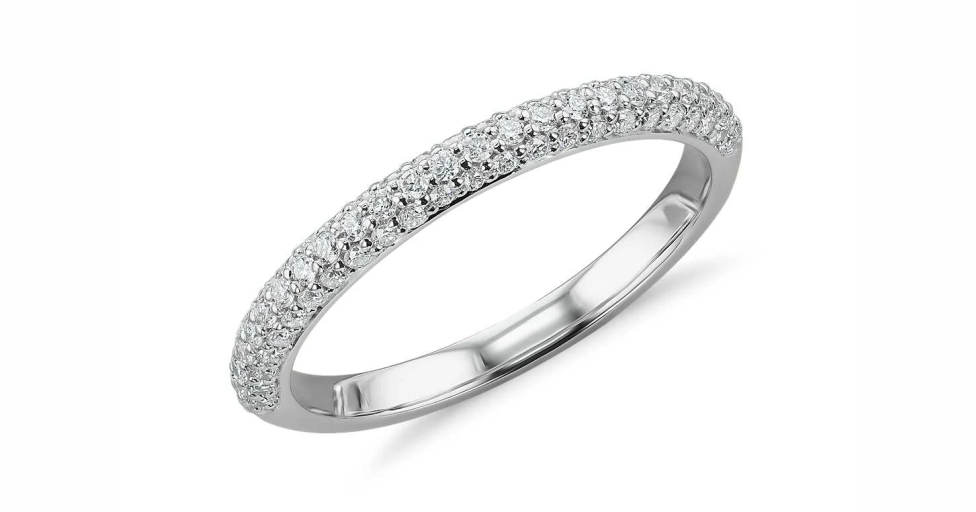
Pave settings, renowned for their extraordinary brilliance and elegance, are characterized by small diamonds set closely together, creating the illusion of a diamond-encrusted surface. It adds extra sparkle and sophistication to the ring, making it an excellent choice for those who desire a glamorous and dazzling appearance.
Pave settings come in various styles, including micro-pave, which features exceptionally tiny diamonds that create a delicate and intricate look. They can transform any ring into a true work of art, exuding luxury and charm.
| Pros of Pave Settings | Cons of Pave Settings |
| 1. Enhanced Brilliance: Pave settings create a dazzling display of brilliance, as multiple small diamonds reflect light brilliantly. | 1. Maintenance Required: Pave settings may require more maintenance as tiny diamonds can become loose or fall out over time. Regular check-ups are recommended. |
| 2. Elegant and Glamorous: Pave settings exude elegance and glamour, making them a perfect choice for those who desire a luxurious and sophisticated look. | 2. Cost Consideration: The added cost of multiple small diamonds in a pave setting can make it more expensive than some other setting types with a single center stone. |
| 3. Unique Design Options: Pave settings offer a wide range of design possibilities, allowing for intricate and detailed patterns that can be customized to suit personal preferences. | 3. Delicate Appearance: The small size of pave-set diamonds can make the ring appear delicate, which may not be ideal for those seeking a more robust or substantial look. |
Channel Settings
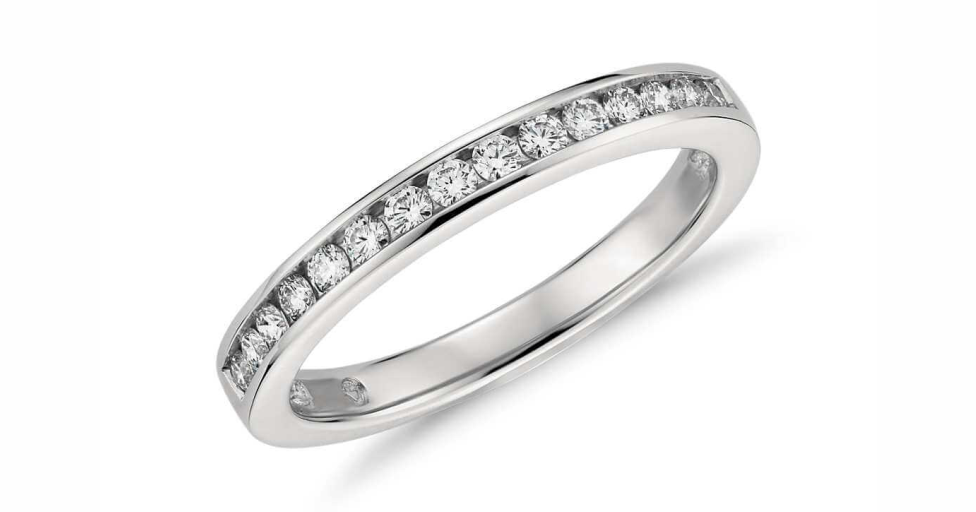
Channel settings offer a blend of security and seamless elegance. They involve a row of diamonds set between two parallel metal walls, creating a smooth, unbroken surface.
Channel settings are available in various metals and can complement other ring styles beautifully. They work well with a variety of diamond shapes, making them a versatile choice.
| Pros | Cons |
| 1. Secure Diamonds: Channel settings securely hold diamonds in place, reducing the risk of damage or loss. | 1. Limited Light Exposure: Channel settings may not allow as much light to enter the diamonds, potentially affecting their sparkle. |
| 2. Sleek and Elegant Appearance: Channel settings create a smooth, uninterrupted surface on the ring, giving it a refined and contemporary look. | 2. Difficult to Clean: The channel can trap dirt and debris, making it harder to clean and maintain the ring’s appearance. |
| 3. Versatile Design: Channel settings are versatile and can be used for various diamond shapes and sizes, making them suitable for both engagement and wedding bands. | 3. Costly Repairs: If a diamond in a channel setting becomes damaged or needs replacement, it can be more expensive and challenging to repair compared to some other settings. |
Tension Setting
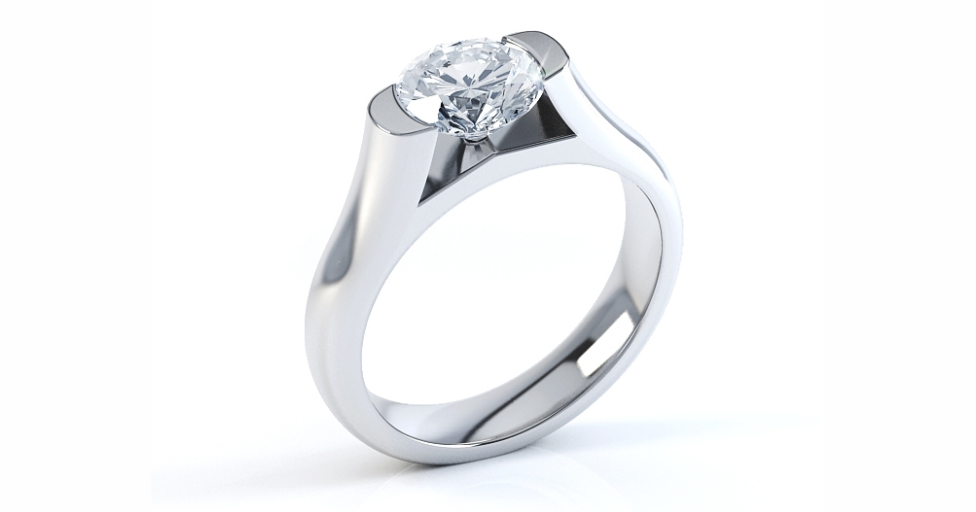
Tension settings, a contemporary and unique choice, hold the diamond in place through tension created by the metal band. This innovative design provides maximum visibility of the diamond, giving it the appearance of floating on the finger.
Tension settings are known for their captivating and eye-catching look. They work best with round or princess-cut stones, enhancing the diamond’s brilliance and creating a conversation-starting piece of jewelry.
| Pros of Tension Setting | Cons of Tension Setting |
| 1. Unique Appearance: Tension settings create a modern and distinctive look that makes the diamond appear as if it’s floating. | 1. Durability Concerns: Tension settings require precise engineering to maintain the diamond’s security. If not properly crafted, there’s a risk of the diamond coming loose. |
| 2. Maximum Visibility: Tension settings offer unobstructed views of the diamond, allowing maximum light entry for enhanced brilliance. | 2. Limited Diamond Shapes: Tension settings work best with specific diamond shapes, such as round or princess-cut, limiting your options. |
| 3. Conversation Starter: Tension settings often catch the eye and serve as a unique conversation starter due to their captivating design. | 3. Sizing Challenges: Resizing tension-set rings can be more complicated and may require the involvement of an experienced jeweler. |
Flush Settings
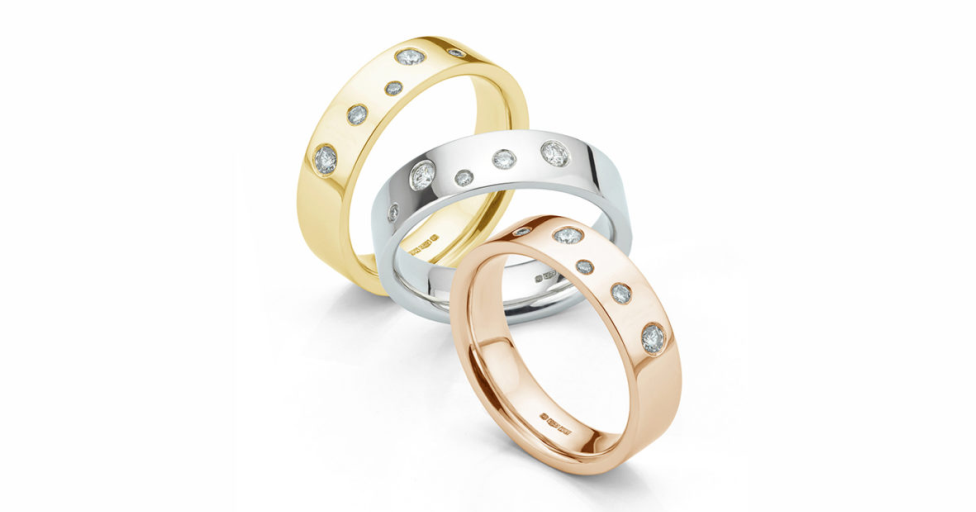
Flush settings are all about subtlety and modern aesthetics. In this type of setting, the diamond is embedded into the metal so that it sits flush with the ring’s surface. This design is sleek and contemporary, emphasizing the diamond’s brilliance while providing protection. Flush settings are often chosen for their minimalist and clean aesthetic, making them an ideal choice for those who appreciate understated elegance.
| Pros of Flush Setting | Cons of Flush Setting |
| 1. Sleek and Modern Aesthetic: Flush settings offer a contemporary and minimalist look, perfect for those who appreciate clean lines and simplicity. | 1. Limited Diamond Visibility: The diamond in a flush setting sits low and is less exposed, which may reduce its brilliance and fire compared to more open settings. |
| 2. Durability and Protection: The diamond is securely embedded into the metal, providing excellent protection against wear and tear. It’s less likely to snag on clothing or other objects. | 2. Challenging Repairs: Repairing or resizing a ring with a flush setting can be more complex and may require a skilled jeweler experienced in this setting type. |
| 3. Comfortable to Wear: Flush settings are often flush with the finger, making them comfortable for everyday wear. There are no protruding prongs or edges to catch on things. | 3. Limited Diamond Size: Due to the design, flush settings may not allow for larger diamonds or stones with intricate cuts, limiting some design options. |
Halo Settings
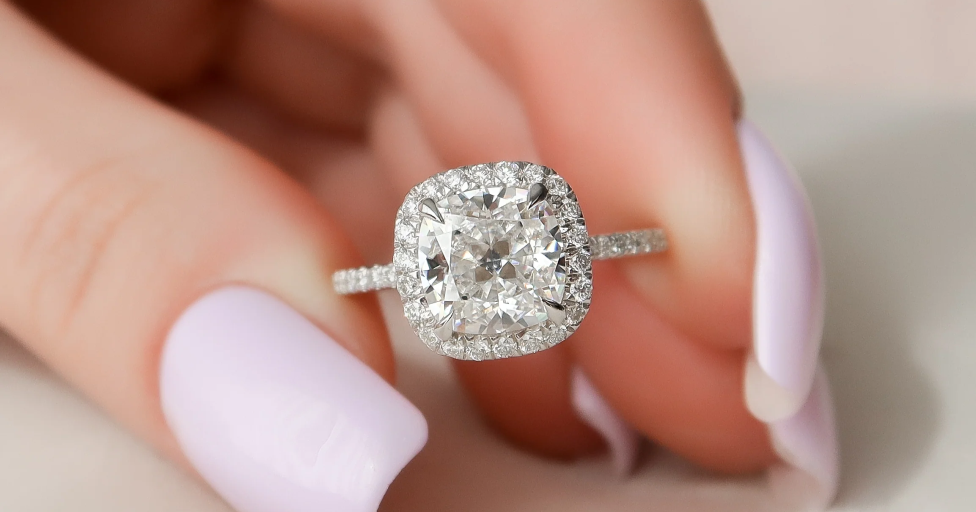
Halo settings are designed to maximize the visual impact of the center diamond. They feature a circle of smaller diamonds surrounding the central stone, enhancing its size and brilliance.
Halo settings work well with various diamond shapes, including round and cushion cuts. They create a captivating and radiant effect, making the center diamond appear even more magnificent.
| Pros of a Halo Setting | Cons of a Halo Setting |
| 1. Enhanced Sparkle: The halo of smaller diamonds or gemstones surrounding the center diamond reflects light and enhances its sparkle and brilliance. | 1. Maintenance: The smaller stones in the halo setting may require more maintenance over time, such as cleaning and potential replacement if they become loose or damaged. |
| 2. Appearance of Size: The halo setting can make the center diamond appear larger than it actually is, adding to the overall visual impact of the ring. | 2. Cost: Adding a halo setting can increase the overall cost of the ring, as it requires additional gemstones and intricate craftsmanship. |
| 3. Durability: The halo setting offers some protection to the center diamond by acting as a buffer against potential damage or chipping, as the smaller stones provide a layer of defense. | 3. Customization Limitations: The design of the halo may limit customization options, as the size and shape of the center diamond need to complement the halo’s design, which can limit your choices. |
Wrapping Up: Types of Ring Setting
The choice of a diamond setting is a significant consideration when selecting an engagement or wedding ring. Each setting type has its own unique characteristics, advantages, and charm. To make the right choice, consider your personal style, the diamond shape you prefer, and the occasion for which the ring is intended.
Remember that consulting with a knowledgeable jeweler can provide valuable guidance and ensure that your chosen setting not only complements your diamond but also represents your love and commitment in a way that resonates with you. Ultimately, the perfect setting will accentuate the beauty of your diamond and create a timeless symbol of your love and partnership.
FAQs
-
What is a diamond setting, and why is it important in a ring?
A diamond setting refers to the way a diamond or gemstone is securely placed in the metal of a ring. It’s a crucial aspect of ring design because it not only holds the stone in place but also plays a significant role in the ring’s overall appearance and functionality. Different setting types can highlight the beauty of the stone, protect it, and influence the ring’s style.
-
What are some popular types of diamond settings for engagement rings?
There are several popular diamond settings for engagement rings, including the classic prong setting, the elegant bezel setting, the vintage-inspired pave setting, and the captivating halo setting. Each of these settings has its unique characteristics and advantages, catering to various tastes and preferences.
-
How do I choose the right diamond setting for my engagement ring?
Selecting the right diamond setting involves considering factors like the diamond’s size and shape, your personal style, and practical considerations. It’s essential to choose a setting that not only complements the diamond but also aligns with your aesthetic preferences. Additionally, consider factors such as durability, maintenance, and how well the setting protects the diamond.
-
Are there any specific maintenance requirements for different diamond settings?
Yes, different diamond settings may have varying maintenance requirements. For example, prong settings may need periodic checks to ensure the prongs are secure, while bezel settings may require less maintenance but might need occasional cleaning to maintain their appearance. It’s crucial to understand the specific care instructions for your chosen setting to keep your ring looking its best.